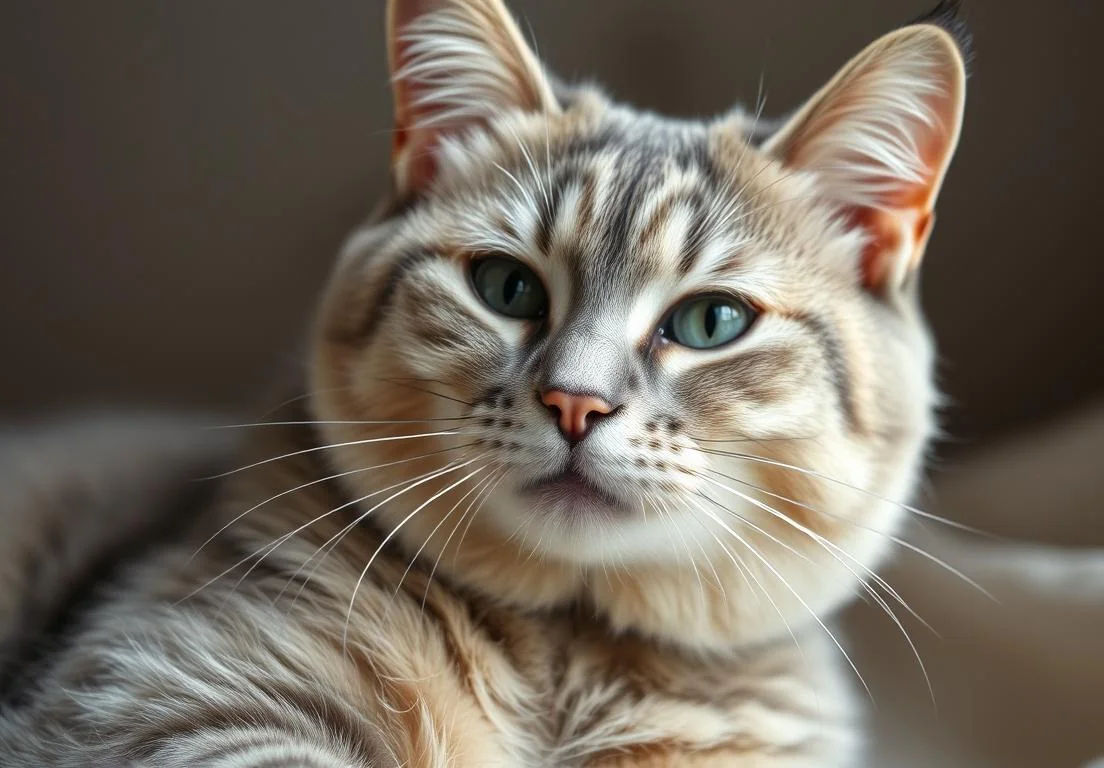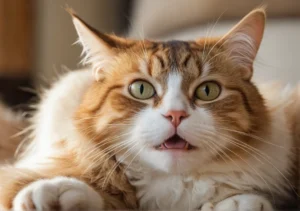Ever notice how your cat seems to purr at the drop of a hat? Whether they’re lounging in a sunbeam or curled up on your lap, that soothing sound is omnipresent. It’s hard not to wonder what’s behind this constant chatter.
Cats purr for various reasons, including contentment, self-soothing, or even healing. It’s a multifaceted behavior that can signify happiness, anxiety, or an instinctive response to pain. But there’s an intriguing depth to feline purring that goes beyond just a happy kitty; secrets of cat communication and well-being await you in this post.

Why do cats purr?
Purring is a fascinating behavior in cats , and it isn’t just about making a sweet sound. While we often associate purring with contentment, this behavior serves multiple purposes. Cats typically purr when they’re feeling relaxed, whether they’re curled up on a sunny windowsill or napping on your lap. It’s their way of communicating reassurance not only to themselves but also to those around them.
Interestingly, purring is also believed to promote healing. The vibrational frequency at which cats purr (between 25 and 150 Hertz) has been linked to various healing processes, such as reducing pain and inflammation. This means your cat might be purring as a self-soothing mechanism or while recovering from an injury.
Additionally, cats may purr when they’re hungry or seeking attention. This type of purring can have a more urgent, higher-pitched tone, akin to a “hunger cry.” In these moments, your furry friend is employing purring as a tool to signal their needs. So, the next time your cat starts purring, consider what they might be trying to convey!
Is my cat purring because they’re happy?
Absolutely, but the context matters! Happiness in cats can manifest in several ways, and purring is a key player. When a cat is relaxed, playful, or getting pampered with some ear scratches, their purring is usually a clear sign of joy.
Look for clues beyond the sound:
- Body Language: A relaxed tail, half-closed eyes, and a lack of tension in their body often accompany purring when a cat is in a good mood.
- Playful Behavior: If your cat engages in playful antics or gently nudges your hand while purring, they’re likely expressing happiness.
- Vocalization: Pairing purring with soft chirps or meows can indicate excitement and delight.
It’s also worth noting that cats sometimes purr when they’re stressed or unwell. While this might seem counterintuitive, they may do so to self-soothe or comfort themselves in situations that feel threatening or painful. So, understanding the broader picture—context, body language, and other behaviors—helps clarify the message behind those soothing vibrations.
Can purring signal distress or anxiety?
Purring isn’t always the sweet, soothing sound it’s made out to be. It can also signal distress or anxiety. While you might think your kitty is just content, purring can have a complex meaning. Cats often purr when they feel threatened, scared, or overwhelmed. If your feline buddy seems to purr more during stressful situations—like visits to the vet, loud noises, or changes in their environment—it’s a sign they might be trying to self-soothe.
Look out for additional accompanying behaviors that can give you more context:
- Hiding: Seeking refuge can indicate they’re feeling anxious.
- Ears back: This signals discomfort, even while they purr.
- Lethargy: If they’re less active than usual, this can be linked to stress.
- Aggressive behavior: A sudden change in personality can mean something’s bothering them.
Observing these cues can help you gauge whether your cat’s purring is a sign of pleasure or a cry for help.
Why do cats purr when they’re in pain?
Purring may seem like an odd reaction to pain, but many cats do it to self-soothe. Research suggests that the frequency of a cat’s purr, typically between 25-150 Hertz, can actually promote healing. This range is linked to various health benefits, including reduced pain and inflammation.
Interestingly, lying in a cozy spot and purring might be a cat’s way of coping with discomfort. They might not just be communicating their pain but actively using the act of purring to help alleviate it. It’s like they’ve employed their own built-in analgesic.
If you notice your cat purring while displaying other pain indicators such as:
- Withdrawal from activities: Lethargy or hiding can indicate they’re hurting.
- Change in appetite: Eating less can be a sign they’re not feeling well.
- Vocalization: Unusual sounds can accompany their typical purring.
- Sensitivity to touch: They may react strongly to being petted in specific areas.
Being alert to these signs may make a difference in addressing your cat’s health needs. If you suspect your furry friend is in pain, it’s best to consult your vet for a thorough check-up.
Do different cats purr differently?
Cats truly have their unique ways of expressing affection and comfort through their purring. Not every cat’s purr sounds alike; in fact, it can vary significantly based on personality, breed, and even mood. Some cats have a deep, resonant purr, while others may produce a higher-pitched, softer sound.
Breeds like the Maine Coon or Siamese often purr more melodically, while some mixed-breed cats might have a more subdued purr. Additionally, a cat’s environment plays a role. A relaxed cat is more likely to purr gently, while a stressed or agitated cat might produce a more erratic, distressed sound.
It’s also worth observing that factors like age and health can influence purring. Kittens begin purring as young as a few days old to signal to their mothers. Meanwhile, older cats might purr in response to pain or discomfort, effectively seeking comfort and reassurance.
Ultimately, understanding the subtle differences in your cat’s purr can deepen your bond with them. It’s their own special way of communicating, and tuning into those nuances can foster a closer relationship.
Can purring have healing properties?
The potential healing benefits of purring are fascinating and increasingly supported by research. A striking fact? The frequency of a cat’s purr, generally around 25 to 150 Hertz, is within the range that studies suggest may promote healing.
This frequency is thought to facilitate tissue regeneration, reduce pain, and even alleviate stress. For instance, some studies show that exposure to low-frequency vibrations can promote healing in bones and soft tissues.
But it’s not just for cats . Humans may also experience therapeutic effects from a cat’s purring. The calming sound can help reduce anxiety, lower blood pressure, and potentially even improve mood. Many cat owners report that simply having their cat nearby while it purrs can bring immense comfort during stressful times.
Interestingly, researchers are exploring the possibilities of using purring as a form of therapy in healthcare settings, harnessing its calming sounds to aid patients with various conditions. So, next time your cat nestles up and starts to purr, know there’s a lot more happening than just a happy cat—it could be a little bit of healing magic too.
How does purring relate to other sounds?
Purring isn’t just a soothing sound; it communicates a range of emotions and needs. While purring often indicates contentment, it can also occur in different contexts, making it more complex than mere pleasure. For instance, some cats purr when they’re frightened or injured, using it as a self-soothing mechanism or a way to signal to others that they’re in distress.
Comparing it to meowing, you’ll notice a stark contrast. Meowing is primarily a communication tool aimed at humans, signaling everything from a greeting to a demand for food. Each meow is unique, often varying in pitch and intensity. Other vocalizations include hissing or growling, which convey clear warnings or discomfort. Purring sits somewhere in the middle—it can signal comfort but also express a cat’s need for help. Cats are nuanced communicators, and understanding their sounds can deepen your bond with them.
Is purring a learned behavior?
Kittens start purring at around two days old, often in the presence of their mothers. This early purring serves several vital roles in their development. For one, it’s a vital bonding mechanism between kittens and their moms, helping to strengthen their connection. Mothers can also respond to their purring, knowing their kittens are nearby and content.
Interestingly, young kittens might use purring as a way to communicate with their mothers, signaling that they’re feeding or need attention. This instinctual behavior can create a lasting pattern, as cats generally continue to purr throughout their lives, reinforcing this early learned behavior. So, yes, it’s safe to say that purring does have roots in learning and bonding—an endearing sign of a cat’s relationship with its family and environment. Plus, as they mature, they might adapt their purring to communicate with humans, showcasing how flexible and intelligent they really are.
What’s the history of cats and purring?
Purring is more than just a cute sound that comes from your feline friend; it’s deeply rooted in their evolutionary history and survival mechanisms. While domesticated cats are famous for the soothing vibrations they produce, the act of purring serves various purposes in the wild.
Cats typically start purring when they’re content, but it’s also a way for them to communicate. Mother cats purr to soothe their kittens, creating a calming environment right from the start. This gentle rumble can signal that all’s well, helping kittens relax and feel safe. Additionally, purring is believed to have healing properties. Research suggests that the frequencies of a cat’s purr (around 25 to 150 Hertz) can help in bone regeneration and healing tissue. In nature, this ability may have contributed to their survival, allowing them to recover from injuries more quickly.
Interestingly, not all felines purr in the same way. Big cats like lions and tigers can produce a similar sound, but they do it differently. Their purring is more associated with breathing patterns rather than the continuous vibrations seen in smaller cats. This difference highlights the versatility and adaptability of purring among various feline species throughout history.
Unique facts about cat purring
Cat purring is filled with surprising tidbits that many cat owners may not realize. Here are some unique insights:
Purring frequency has purpose : The frequency of a cat’s purr isn’t just a random sound; it ranges typically between 25 and 150 Hertz, which is similar to frequencies that promote healing in muscles and bones.
Not just for happiness : While cats often purr when they’re happy, they also do it to soothe themselves when they’re stressed, in pain, or even when they’re sick. It’s a form of self-comforting behavior, bridging the emotional gap during tough times.
Cats purr while they eat : You might notice your cat purring while eating. This behavior can indicate satisfaction but also facilitates the act of eating, potentially enhancing their motivation to consume food.
Some cats are silent purrers : Believe it or not, some cats manage to produce a purring sensation without any audible sound. You might feel the vibrations, but won’t hear a thing!
Purring as a social tool : Cats are social creatures, and purring can serve as a form of communication between cats, signaling non-aggression, and fostering bonds among feline friends.
Purring is an intricate behavior that resonates both physically and emotionally with cats, highlighting their complex roles as both solitary and social creatures. It’s a charming feature that can connect you deeper with your feline companion.
Alex, a passionate animal lover, has experience in training and understanding animal behavior. As a proud pet parent to two dogs and three cats, he founded AnimalReport.net to share insights from animal experts and expand his knowledge of the animal kingdom.




